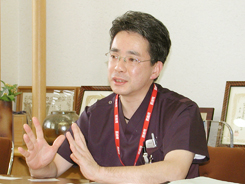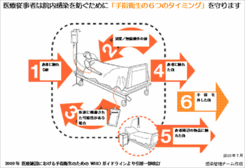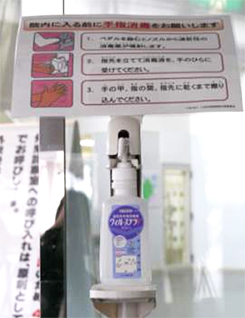Hand Hygiene as a Countermeasure against the Norovirus Outbreak

Sanda City Hospital
-
Address:3-1-1 Keyakidai, Sanda city, Hyogo, Japan
-
Number of beds:300 (general)
-
Total number of staff:589 (including contract)
-
Number of surgeries:2,561 (April 2010 to March 2011)
-
Website:https://www.hospital.sanda.hyogo.jp/
※Saraya Co., Ltd.'s privacy policy does not apply to linked external websites.
Please refer to the privacy policy posted on the site.
Interviewees

Mr. Tomoyuki Nakamura
Background
Outbreak and the initial response
- Please tell us about your countermeasures against the norovirus outbreak last winter.
|
Mr. Tomoyuki Nakamura |
On January 18, 2011, we confirmed that several patients in one ward manifested diarrhoea, so we held an emergency Infection Control Committee (ICC). After the investigation, we found that the symptoms were due to infectious gastroenteritis (IGE), and we started taking countermeasures based on the understanding that we were addressing an outbreak. ICC took initiatives to regulate the admission and transfer of patients to the ward, including the reception of emergency outpatients from January 18th to the 30th. We also promoted hand hygiene implementation, enforced improvements in personal protective equipment (goggles were changed to face shield, and protecting gown was changed to the one with a higher barrier property), required the use of surgical masks for all staff on duty, and reviewed toilets and environmental sanitation practices. We conducted emergency meetings at medical offices and held a hospital-wide training at an early stage of the outbreak so that all staff was informed that "an outbreak of IGE has occurred". Our efforts resulted in a high compliance rate of prevention measures. |
||
Considering the introduction of Alsoft V
- What made you consider adopting Alsoft V?
We focused on hand hygiene because contaminated hands account for many cases of norovirus transmission. Saraya Sales had introduced Alsoft V as an effective product against the norovirus, so we considered adopting it. We contacted the sales person immediately after we received confirmation that the patients' symptoms resulted from the norovirus, and we started using Alsoft V the evening of January 18th.
- Did you have any concerns using Alsoft V?
We were concerned about potential damage to the hands of our staff members since the pH of this product leans on the acidic side. However, we did not hear any reports from staff about dry skin or skin irritation.
- How did you manage to familiarize the use to all staff?
| We base our hand hygiene protocol on the "5 moments for hand hygiene" suggested by WHO. We advocate hand hygiene at 6 moments, adding to WHO's recommendations our original 1 moment, "after removing gloves". Until then, our guideline for hand hygiene under possible norovirus contamination was "hand wash with running water and soap", but with Alsoft V, we can expect efficacy against the norovirus. Thus, we have announced a new procedure for hand hygiene. Follow the regular guideline when the hands are clearly dirty, and conduct hand rub with Alsoft V when there is no visible soil. |
"6 moments for hand hygiene" at Sanda City Hospital |
||
After implementation of Alsoft V
- Where did you place Alsoft V?
| We require Alsoft V to be used during epidemics or outbreaks of norovirus. During the last outbreak, we placed bottles at the ward where the patients showed symptoms, the outpatient ward, and by request of the medical offices, in the duty doctor's rooms and in medical offices. Even though the outbreak has ended, we continue to place a bottle at each entrance of the hospital to prevent bringing the virus in from outside. It is set in a foot pump-operated dispenser, allowing users to dispense the Alsoft V on their hands without touching the pump. There is also a large panel with instructions for use. |
Alsoft V placed at the entrance of the hospital |
||
- Did anything change by the outbreak and change in hand disinfectant?
Along with changing the hand disinfectant, we conducted briefing sessions and study sessions that informed staff how to use it. We also addressed hand hygiene enforcement. As a result, staff awareness about infection control has improved, resulting in increased efforts to maintain hand hygiene. Consumption of hand disinfectants increased drastically, too.
- How effective was Alsoft V as a measure against the outbreak?
We implemented multiple countermeasures when the outbreak occurred, so we cannot confirm the sole effectiveness of Alsoft V. However, I believe that we were able to end the outbreak early and prevent the transmission of the norovirus to our staff with our actions. During the outbreak (11 days), 4 staff members developed symptoms that suggested they were infected by the norovirus, but quick inspections revealed it was not present in these cases. I would say the biggest success in our response to the outbreak was that we were able to prevent the transmission of the norovirus to our staff.
NEXT STEP
- What are your thoughts about hand disinfectants from now on?
We are currently considering what we will use once the norovirus epidemic ends, including stopping the use of Alsoft V and returning to the hand disinfectants we used prior to the outbreak. Although IGE increases in the winter, it exists year-round, so we are thinking about keeping it. We are planning to discuss this issue at future ICC meetings.
- Tell us what you will work on next.
Needless to say, we must improve the compliance rate of general prevention measures and IGE measures among all staff. We are also considering implementing "pandemic phase measures", such as offering a "flash report on IGE countermeasures" through the hospital intranet, based on epidemic situation data gathered from the Hyogo prefecture, the health centre area, and outpatients.




